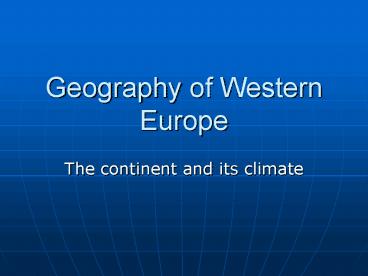Geography of Western Europe - PowerPoint PPT Presentation
1 / 16
Title:
Geography of Western Europe
Description:
Great Britain, Ireland and Iceland are islands in the Atlantic. ... Pyrenees-forms a mountain wall between the Iberian Peninsula and the rest of Europe. ... – PowerPoint PPT presentation
Number of Views:2380
Avg rating:3.0/5.0
Title: Geography of Western Europe
1
Geography of Western Europe
- The continent and its climate
2
Western Europe
- Europe and Asia are both called continents,
although they are both located on the same great
landmass. These two continents are separated by
the Ural Mountains. The landmass is called
Eurasia. Europe is a peninsula of Eurasia.
3
Europe
- Map
4
Western Europe
- Even though Europe is a small continent, it has a
long coastline because of its shape. Several
smaller peninsulas extend into the seas from the
larger peninsula of Europe. Italy forms a
boot-shaped peninsula. Spain and Portugal are on
the Iberian Peninsula. The Balkan peninsula is
divided into six countries Greece, Albania,
Bulgaria, Romania, Turkey, and Yugoslavia.
5
Western Europe
- Scandinavian peninsula is made up of Norway and
Sweden. Jutland is a smaller peninsula made up
of Denmark.
6
Western Europe
- Most of the lands that make up Western Europe are
located on the western part of the mainland, but
some are not. Some are islands. Great Britain,
Ireland and Iceland are islands in the Atlantic.
Malta and Cyprus are islands in the Mediterranean
Sea.
7
Western Europe
- Term Western Europe grew out of history rather
than geography. After World War II, the continent
was divided. The countries of Western Europe
remained free of Soviet control.
8
Western Europe
- Because of the continents shape, no place is
more than 300 miles from the sea. Ships can enter
through the Strait of Gibraltar. Here only about
¾ mile separates Europe from Africa. Ships can
sail from the Aegean Sea through the Dardanelles
and Bosporus into the Black Se. The North and
Baltic seas provide routes to Northern Europe.
9
Western Europe
- The Alps-largest group of mountains in Western
Europe. The Alps from parts of France,
Switzerland, Italy, Germany, Austria, and
Yugoslavia. Waters from the Alps flow into four
of Europes major rivers the Rhine River, the
Rhone River, the Po River, and the Danube River.
10
Western Europe
- Physical map
11
Western Europe
- Pyrenees-forms a mountain wall between the
Iberian Peninsula and the rest of Europe. They
are not as tall as the Alps, but are very rugged.
12
Western Europe
- Natural resources-forests
- Deciduous trees (leaves fall off)
- Coniferous trees (cones)
- Black Forest- large forest in Germany
- North European Plain has an abundance of good
soil and plentiful rainfall.
13
Western Europe
- Minerals
- Coal, iron, lead, zinc, copper, salt, oil, and
limestone - Limestone is necessary for making concrete. Oil
was discovered offshore in the North Sea.
14
Western Europe
- Mining and manufacturing
15
Western Europe
- Ocean currents affect the climate of Western
Europe. - Gulf Stream flows north and east from the warm
waters of the Gulf of Mexico into the North
Atlantic. Air blowing over Western Europe from
off the North Atlantic usually keeps winter
temperatures warmer. - Altitude also affects climate. Places at high
elevations, such as the Alps, are cooler than
places at low elevations.
16
Western Europe
- Climate map































